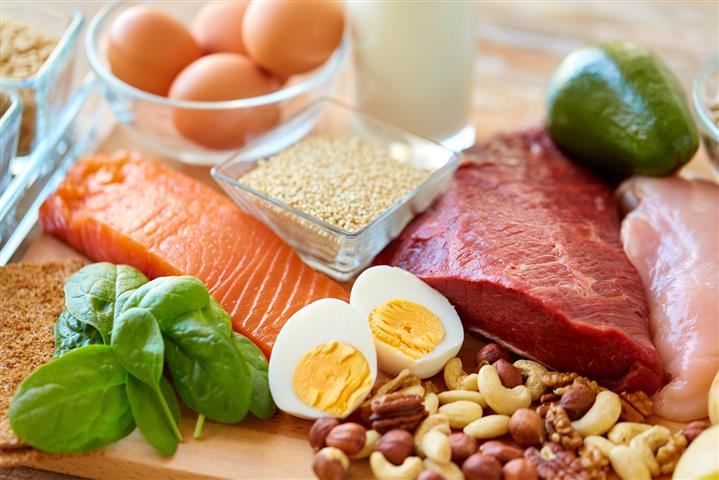The ketogenic diet is one of the best diets out there when it comes to weight loss and general health.
Thousands of success stories can be found in online forums, on social media, and on different keto websites (don’t forget to check out the success stories of our readers, too!).
An increasing number of people swear by keto’s advantages, especially in terms of weight loss and maintenance.
And indeed, studies have shown it to be very effective, especially for obese patients, so it’s not just a word of mouth (1).
Why is that, though?
Do you still need to be in a caloric deficit in order to lose weight? Or does keto have a different mechanism of action?
The short answer is that yes, even on keto you need to be in a caloric deficit to lose weight.
If you want to drop the excess body fat, you’ll need to force your body to use your own fat stores, and this is achieved through maintaining a deficit over a period of time (typically at least a few weeks or months, based on your goals and how aggressively you’re willing to diet).
Regarding Energy Balance and Gaining Weight
Your body doesn’t easily part with fat, as fat is its built-in energy storage solution, and as such, it’s an incredibly efficient one.
Anthropologically speaking, gaining weight is a survival strategy necessary for pushing through leaner periods of time, and through times of famine.
Food sources in the wild can range from abundant to few and infrequent, so storing fat is the most natural way to deal with food shortages – if you don’t find any food in the next few days, you’d better be well prepared to survive and stay fit and able to continue searching for your next meal.
The main issue with that mechanism, and the reason it’s sometimes failing to keep us healthy and within a reasonable weight range is exactly because it’s super effective.

We, as a species, haven’t (yet) had the time to adapt to the unprecedented abundance of easily accessible and strongly processed calories that we don’t need to hunt, chase, gather or harvest ourselves. We just need to open the fridge, or go shopping.
We also need to take into account the fact that a huge amount of calories that are consumed nowadays come in the form of highly processed food that is designed to be hyper palpable and incredibly tasty – they’re effectively overriding our natural hunger and satiety signals.
Consuming carbs in excess can also play a role in gaining weight, especially if they’re refined.
It’s not that carbs are fattening as such – again, a calorie is a calorie – but rather that the blood sugar fluctuations that they create will easily stimulate us to eat more than necessary.
Plus, as we pointed out, processed food is often intentionally designed to be extremely tasty – the right amount of salty, sweet or crunchy makes it super easy to eat too much of it (in terms of energy), without even realizing it.
Combining all of this with the complex role food plays in our emotional and social life makes everything that much more difficult.
Add to the mix the fact that a lot of people have office jobs and generally sedentary lifestyles, and you’ll quickly see how an excess of energy can and will be stored in the form of fat.
This combination of factors makes us especially vulnerable to conditions such as obesity, metabolic syndrome, insulin resistance and the like.
Thankfully, the keto diet can help a lot, if you’re already suffering from any of these, and also lower the risk for them. It can also make it easier to eat fewer calories and sustain a deficit.
The reason for this is that keto acts as an effective appetite suppressant for many people, making it easier to consume less energy without feeling excessively hungry.
Do bear in mind, though, that some hunger when losing weight is normal and is a part of the process – even on keto.
Additionally, if you’re working out a lot, note that cardio tends to make you hungrier (and even ravenous at times), so if you’re doing lots of cardio and are bothered by hunger, you might want to dial it down a bit.

Lifting weights or a combination of resistance training and some cardio can be great when aiming to create bigger deficits and lose weight (and put on some muscle – which will both help you burn fat and look better).
If you’re active and exercising, do not add back exercise calories.
Estimations on calories spent during exercise are almost never precise (and especially not on gym machines) and many people tend to overestimate the energy they have used.
If you’re much hungrier on training days, you can distribute your total weekly calories in a way that you will be eating slightly more then, and slightly less on rest days.
Another positive effect of keto, which makes it generally easier to stay in a deficit, is that if you limit carbs significantly, your blood sugar will be much more stable, and your body won’t be relying on the quick energy that carbs provide (and that is easy to deplete), but on fats instead. You’ll be able to eat less frequently (and limit snacking), and use your fat stores instead.
How Do You Calculate The Deficit Needed For Weight Loss?

In order to figure out how many calories you need to eat in order to lose weight, you need to first figure out what your maintenance calories are, and then subtract from that number a certain percentage.
Everyone has slightly different energy needs, which also vary from day to day, and can change over time.
Nevertheless, in order to start from somewhere, you’ll need to make a guess regarding your maintenance calories, and your best bet would be to make an informed estimation and then see whether it’s correct by experimenting.
The best method for figuring out your maintenance calories and the deficit you need to lose weight, is to track your intake and to observe your body.
If, say, at 1800 calories your weight stays stable over a couple of weeks, then that’s where your maintenance calories are at, at your current activity level.
This method, however, takes a lot of time, as any change in body fat that is significant and measurable will not be quick.
In order to start the process quicker than that, you can use an online calculator to get an estimate and use that as a starting point. After that, you can adjust based on your results.
Keep in mind, though, that weight loss takes time and is not linear – if you see no changes at first, do not feel discouraged.
If you’ve hit a weight loss stall that lasts for more than 3-4 weeks, there’s a number of strategies you can try out – check out our article on the topic!
When deciding on the specific deficit you want to maintain, the best strategy would be to subtract from your maintenance calories a certain percentage, and not just a random number, such as 500 calories.
Typically, selecting a percentage between 10 and 25% is a successful strategy for most people. Opting for a lower percentage (between 10 and 15%) will mean that weight loss will be slower, and you also need to account for the fact that tracking cannot be 100% accurate.
A higher deficit percentage (f.e. 25%) will mean that weight loss will be faster and more noticeable. However, it might be physically and mentally draining to stick to it in the long run, and you might sometimes feel really hungry.
In general, it’s a good idea to choose a moderate deficit, such as 15%-20% – if you’re strict about it, the weight will come off, and it won’t feel extremely difficult to maintain.

On keto, you’ll be eating whole and nutritious foods that will be filling, and the fact that it has an appetite suppressing effect will help you stay on track. Protein and fats will generally keep you fuller and feel more satisfying.
Nevertheless, dieting is always stressful for your body, and it might be a good idea to sometimes give yourself a break – go back to maintenance calories for a week after 4-6 weeks of dieting to make it easier.
There’s another, slightly different approach that some people find easier to adhere to – instead of always keeping the same deficit every day, you might choose to have days when you eat a bit more and days when you eat a bit less. You can think of your deficit as a weekly goal rather than a daily one, and strive to maintain it on a weekly basis.
Let’s make a simple calculation
As an example, we’ll assume that your maintenance calories are approximately 2000, and you have settled on 1600 for weight loss, or a 20% deficit. This means that in a week you need to be consuming 11200 calories in order to maintain your deficit.
Let’s say that you eat 1500 calories from Monday to Thursday – this will allow you to have 400 more calories spread over the weekend. Another example – on a given day you might feel less hungry than usual and eat 1400 calories. This will allow you to eat 1800 calories on the next day, if you’re hungrier – you’ll have a “credit” of 200 calories.
Keep in mind, though, that you still need to maintain an overall deficit in order to lose weight with that strategy – you cannot consume 1500 calories four days a week and then consume 3000 a day for the remaining three days, and expect to lose weight.
A note on tracking
Tracking is necessary in order to know how many calories you’re consuming. Many people underestimate the calories they’re eating (and often, by a lot), which can undermine weight loss efforts and discourage you (2).
Additionally, on keto you need to be particularly strict when tracking, in order to make sure that you’re staying under your carb limit.
This is why we advise getting a food scale and using a tracking app (eyeballing food is not sufficiently precise). While it might be confusing at first, tracking will become much easier with time, and will almost become a second nature.
Related: Best Apps & Trackers to Track Your Macros on Keto Diet
How About All The People Who Claim They Can Eat Whatever They Want And Still Lose Weight On Keto?
Simply put, they’re actually still in a deficit!
Their maintenance calories might be much higher than where online calculators put them at, but if they’re losing weight, this essentially means that they’re spending more energy than what they’re eating.
Everybody’s metabolism is slightly different, and it depends on a myriad of factors, such as age, weight, height, muscle mass, activity level, and so on.
Also, the actual types of food that you are eating might cause you to lose some energy as heat to process that specific food. It’s called the Thermic Effect of Food (TEF) (3).
Just so you know, when you eat a meal, the thermogenic effect usually accounts for approximately 10% of calories of that meal (4, 5).
There are several foods you can eat to increase the thermogenic effect on the body, such as cayenne pepper and green tea. These foods “heat up” your metabolism, allowing you to burn more calories than other foods.
Research shows that a diet high in protein also has a thermogenic effect on the body (6). High protein diets also tend to be very satisfying, which can further contribute to weight loss by keeping you full.
In short, your daily energy expenditure will be based on 3 primary factors:
- Basal metabolic rate (BMR – the calories you burn while at rest)
- Diet-induced thermogenesis (Thermic effect of food or TEF)
- Energy you burn while doing some sort of physical activities
You cannot lose your body fat without some sort of calorie deficit. Every bodybuilder and physique athlete know that they need to have a caloric deficit to drop their body fat percentage to prepare for their competition (7).
Online calculators provide an estimate and cannot be 100% precise.
If you’re losing weight at 2200 calories daily while most calculators put you at 1800, it simply means that your maintenance calories are actually higher than what these calculators estimate.
Keep in mind that this will change with time – as you’re losing weight, your energy needs will decrease, as you simply weigh less and need to move less weight through space. It’s a good idea to recalculate your calories at approximately every five pounds lost in order to continue losing weight.
Our conclusion
Keto is awesome for weight loss, as it will help you keep your hunger in check, while giving you access to your fat stores. You still need a deficit to be able to lose weight, and the most important thing to do is to have your daily calories in check, to make sure you’re staying under your maintenance energy needs.
If you’re exercising (be it for creating bigger deficits, or for gaining muscle, or both), it’s best to not add back exercise calories. Diet is the most important factor for weight loss; exercise has a number of amazing benefits, but it’s actually not a must.
Once you achieve the weight loss you’ve been aiming for, you can switch back to maintenance calories; additionally, in order to make dieting easier, it’s a good idea to go for maintenance once a week every month or two, in order to have a break from dieting and to make things easier for your body.
Once you lose the fat you’ve been wanting to lose, it’s essential to continue eating healthy and be mindful of your food choices. If you just go back to the way of eating that made you gain weight, you risk gaining it again – and then more.
Have you already figured what your maintenance calories are? What is the deficit you have settled for? Do you always eat the same calories, day after day, or do you mix things up a little during the week?
Share your experience with us and our readers in the comments below!
Up Next: Top 14 Ketogenic Diet Mistakes and Why You Are Not Losing Weight







